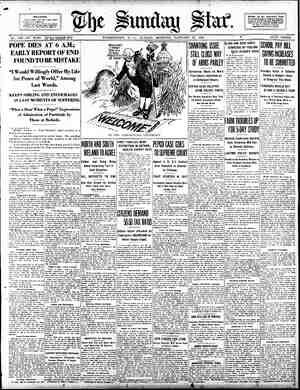Casper Daily Tribune Newspaper, January 22, 1922, Page 33
You have reached the hourly page view limit. Unlock higher limit to our entire archive!
Subscribers enjoy higher page view limit, downloads, and exclusive features.
- Ae ee The wealth of Casper and Natrona County is derived from three principal sources, the sheep industry, thé cattle industry and the great oil fieids and refineries which are pane millions of dollars into the city, county, state and nation. The slow and gradual development of the oil fields ad- _ Jacent to Casper, insures the future business stability and dependability of this section, by affording ample time for the.development of agriculture, the basis of permanent future prosperity, by means of the Casper-Alcova Irriga- tion Project. get er will irrigate approximately 100,000 acres of fertile soil adjacent to sept and when it is com- pleted we may expect the development in Casper which is the inevitable result of diversified farming, The irrigated area should supply sugar beets for a fac- tory located at Casper, with an annual production of six- teen thousand tons of sugar. The pulp derived from 110,000 tons of raw beets, which should be the average annual production for 11,000 acres of beets, will fatten 6,875 two-year-old steers every sea- son. This will enable the cattle men to fatten their own range stock for market at minimum cost. Sugar beet Natrona County is destined to become an inland em- «*" pire; with an abundance of petroleum, natural gas, as- bestos, copper, iron, limiestone ,gypsum, sodium and other aatnerale and its natural resources unbounded, while un- limited water power from Boysen, Pathfinder and the pro- jected Alcova Dams will-supply the dynamic energy to weld the City of Casper with its mineral resources, its 5_ aerated be 1 100,000 acres--Total acreage : THE CASPER PAILY TRIBUNE AND WYOMING WEEKLY REVIEW aii ts also excellent feed for fattening sheep, of which we ware sy as ave 225,000 in Natrona Comnty. i ; b] te Fifty thousand acres of alfalfa averaging three tons to the acre, 150,000 tons annually, will provide hay for thou- sands of cattle and sheep and thus permit the Natrona County tanchman to pick his own market and avoid sonal marketing which has always been a serious handi- cap to Wyoming ranchmen. Our alfalfa is unexcelled for the making of alfalfa meals and stock foods. Fifteen thousand acres of small grains will produce a crop of 250,000 bushels of wheat, 41,000 bushels of oats, 18,000 bushels of rye, 37,000 bushels of barley annually. The wheat will supply a flour mill in Casper having 108 barrels daily capacity and most of the other grains will be fed to stock by the farmer, Five thousand acres of potatoes should yield annually an average of 750,000 bushels, enough to feed the City of Casper and operate a starch factory with an annual out- put of 5,625,000 pounds of starch, Four thousand acres of corn should produce an average annual yield of 100,000 bushels of corn, or 28,000 tons of ensilage. Twenty-eight thousand tons of ensilage will winter 3,000 head of dairy cattle and 13,660 head of beef - cattle. - Estimate Acreage 50,000 acres alfalfa ; 11,000 acres sugar beets 15,000 acres small grains 5,000 acres potatoes 4,000 acres corn 10,000 acres pasture for domestic stock 4,000 acres home:grounds, stock corrals, feed lots, gardens to supply the Casper mar- ket with green vegetables. stock rdising and agricultural advantages Into the great- est industrial center west of the Missouri River, , a Casper does not aspire to be the mecca of the get-rich- quick speculator. We want to encourage home builders to come here and work with us for a greater and better ae Chamber of Commerce of Casper, Wyoming | ‘Anyone desiring to come to Casper in the near future to seek employment or business opportunities would do fe well to communicate with thig } m before incurring the expense of a trip here, TAC TT H LE Ra RT

